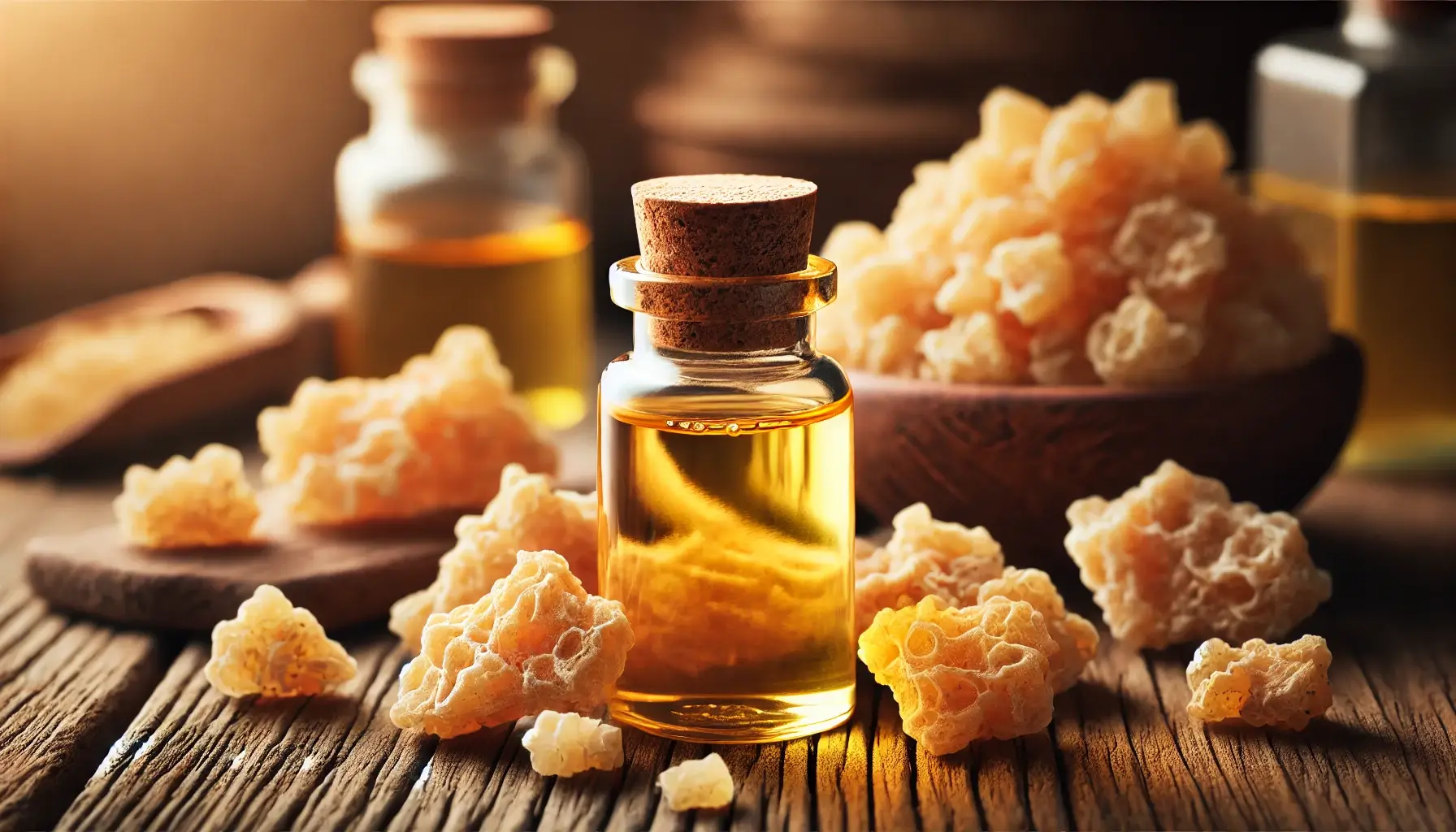Frankincense oil is an essential oil derived from the resin of the Boswellia tree, particularly the Boswellia sacra species. Known for its aromatic and therapeutic properties, frankincense oil has been used for centuries in various cultures around the world. This article will explore the history, extraction process, benefits, uses, and potential side effects of frankincense oil, providing a comprehensive understanding of this remarkable substance.
What is Frankincense Oil?
Frankincense oil is an essential oil that comes from the resin of the Boswellia tree, particularly the Boswellia sacra, which is native to regions in the Arabian Peninsula, India, and Africa. The oil has a warm, spicy, and woody aroma, making it a popular choice in perfumes, incense, and aromatherapy.
The term “frankincense” originates from the Old French term “franc encens,” meaning “pure incense.” It has been valued throughout history for its aromatic and medicinal properties. The oil is often used to promote relaxation, support skin health, and improve overall well-being.
A Brief History of Frankincense
Frankincense has a rich history that dates back thousands of years. It was one of the gifts presented to the baby Jesus by the Wise Men, symbolizing its importance in ancient cultures. The Egyptians used frankincense in religious rituals, mummification processes, and as a perfume.
In ancient Rome, frankincense was used for its healing properties and was burned in temples during worship. It was also traded along the Incense Route, which connected the Mediterranean with the East, highlighting its significance in commerce.
The oil has been an essential part of traditional medicine in various cultures. In Ayurvedic medicine, it has been used to treat respiratory issues, skin problems, and digestive disorders. The use of frankincense oil continues to thrive today, with many people turning to it for its numerous health benefits.
How is Frankincense Oil Extracted?
The extraction of frankincense oil involves several steps. Here’s a breakdown of the process:
- Tapping the Boswellia Tree: The process begins by making cuts in the bark of the Boswellia tree. This allows the resin to ooze out and harden into what is known as “tears.”
- Harvesting the Resin: After a few days, the hardened resin is collected. This resin is the primary raw material used for producing frankincense oil.
- Steam Distillation: The collected resin is then subjected to steam distillation, a process that involves steaming the resin to release the essential oil. The steam helps separate the oil from the resin, which is then collected.
- Cooling and Bottling: After distillation, the oil is cooled and bottled. Pure frankincense oil can be clear to pale yellow and has a potent, earthy aroma.
The quality of frankincense oil can vary based on the extraction method and the region in which the Boswellia trees are grown. High-quality oil is typically produced from trees that are at least 10 years old, as older trees yield a more potent and aromatic resin.
Benefits of Frankincense Oil
Frankincense oil is celebrated for its myriad health benefits. Here are some of the most notable:
Promotes Emotional Well-Being
One of the primary benefits of frankincense oil is its ability to promote emotional well-being. It is known to have calming effects, which can help alleviate feelings of anxiety and stress. Inhaling frankincense oil during meditation or yoga practices can enhance the experience by promoting relaxation and focus.
Frankincense oil contains compounds that can influence the limbic system, the part of the brain responsible for emotions. This makes it an excellent choice for those seeking to improve their mood and emotional state.
Supports Skin Health
Frankincense oil is often used in skincare products due to its ability to improve skin health. It has anti-inflammatory and antiseptic properties, which can help reduce the appearance of blemishes, scars, and stretch marks. It may also promote the regeneration of healthy skin cells.
When diluted with a carrier oil, frankincense oil can be applied topically to help soothe irritated skin, reduce redness, and even out skin tone. Its ability to improve the appearance of aging skin makes it a popular ingredient in anti-aging formulations.
Enhances Immune Function
Frankincense oil is believed to have immune-boosting properties. Its antimicrobial and anti-inflammatory effects can support the body’s defenses against infections. Regular use of frankincense oil, whether through aromatherapy or topical application, may help improve overall immune health.
Some studies suggest that frankincense may enhance the activity of white blood cells, which play a crucial role in fighting off pathogens. This makes it a valuable addition to a holistic approach to health and wellness.
Aids in Digestion
Frankincense oil has been traditionally used to support digestive health. It may help alleviate symptoms such as bloating, gas, and constipation. The oil is thought to stimulate digestive enzymes and promote better digestion overall.
When diluted and applied to the abdomen, frankincense oil can help ease digestive discomfort. It is essential to consult a healthcare professional before using frankincense oil for digestive issues to ensure safety and proper usage.
Has Anti-Inflammatory Properties
Frankincense oil is renowned for its anti-inflammatory properties. This makes it beneficial for individuals suffering from conditions like arthritis or inflammatory bowel disease. By reducing inflammation in the body, frankincense oil may help alleviate pain and improve overall health.
Studies have shown that the compounds in frankincense can inhibit the production of inflammatory cytokines, contributing to its effectiveness in managing inflammation. This makes frankincense oil a natural alternative for those seeking relief from chronic pain and inflammation.
Uses of Frankincense Oil
Frankincense oil can be used in various ways, making it a versatile addition to any wellness routine. Here are some common uses:
Aromatherapy
Aromatherapy is one of the most popular uses for frankincense oil. Its calming scent makes it an excellent choice for diffusing in the home or during meditation. Simply add a few drops of frankincense oil to a diffuser with water and enjoy the soothing aroma.
Inhaling frankincense oil can help reduce stress, anxiety, and promote a sense of peace. It can also enhance mental clarity and focus, making it a great choice for work or study environments.
Topical Application
Frankincense oil can be applied topically to the skin when diluted with a carrier oil, such as coconut or jojoba oil. This method is particularly effective for addressing skin concerns like acne, scars, and signs of aging.
To create a skin treatment, mix a few drops of frankincense oil with a carrier oil and apply it to the affected areas. Always perform a patch test before applying the oil to a larger area to ensure there is no adverse reaction.
Inhalation
Inhaling frankincense oil directly from the bottle or adding it to a bowl of hot water can provide quick relief for respiratory issues. The oil’s soothing properties may help alleviate symptoms of colds, allergies, and asthma.
To inhale frankincense oil, place a few drops in a bowl of steaming water, cover your head with a towel, and lean over the bowl to breathe in the steam. Be cautious with the hot water to avoid burns.
In Cooking
While not as common, frankincense oil can be used in cooking. Its unique flavor can enhance certain dishes, particularly in Middle Eastern cuisine. However, it should be used sparingly due to its strong aroma.
When using frankincense oil in cooking, ensure it is food-grade quality and consult a recipe that incorporates essential oils. A drop or two can be added to marinades, dressings, or desserts for an aromatic twist.
How to Use Frankincense Oil Safely
While frankincense oil offers many benefits, it is crucial to use it safely. Here are some guidelines for proper usage:
- Dilution: Always dilute frankincense oil with a carrier oil before applying it to the skin. A common dilution ratio is 1-2 drops of essential oil per tablespoon of carrier oil.
- Patch Test: Perform a patch test before using frankincense oil on larger areas of skin.













